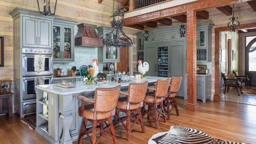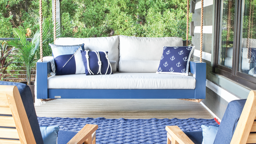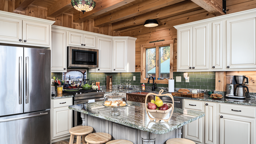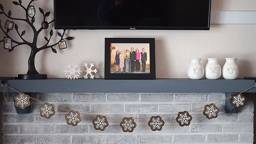|
If you are having troubles putting the finishing touches on your log home, you're not alone. Home decorating tasks can be daunting, but the alternative — living in unfinished spaces — is worse. We asked design professionals to help tackle some of the most common decorating dilemmas, including problems specific to log-home owners. Here are their solutions.
Dilemma #1: "I'm having trouble hanging artwork on my round logs."
Solution: Be flexible.
Artwork hangs best when nailed to the furthest protruding part of the log. "This may mean you will have to make some compromises," says Ang Rodesney, interior designer for Slifer Designs. "It's not always going to be a perfect hang. You have to go with the increments of the logs." Slight height adjustments can be made, though, by altering the wire hanger on the back of the artwork.
Don't worry about hanging art at eye-level. "That rule doesn't make any sense," says Joetta Moulden, stylist for ShelterStyle.com. "Some people are 4'8" and some are 6'5". Plus, in a living room you're often viewing art from a sitting position. Instead, hang art in relationship to what it's near. Hang it 10" above a sofa or 8" above a table." Moulden suggests log home owners buy artwork that spans at least 1 1/2 log courses to prevent awkward hangs where the bottom of the picture kicks out or slants in.
"Too often, homeowners err on the side of timidity," Moulden says. "If you have soaring ceilings, think about how much blank space there is above your mantel, for example. A 16"x20" painting on a mantel will literally look like a postage stamp."
To measure your results take a picture of the room and use the photo to help you decide if the art is placed right — or if it's too big or too small. Digital or Polaroid cameras work great for this because you can see the results right away.
Dilemma #2: "My art fades into the shadows. What's the best way to light artwork?"
Solution: First of all, plan ahead.
"Think about lighting early in the game," Moulden says. "I recommend while building the home you figure out where art will hang and have the electrician pull the wires and hide them under the edge of beams or behind the trim." Second, art lighting should be focused. "I usually suggest some kind of eyeball light that comes out of the ceiling," Rodesney says. "It shouldn't wash the whole room. It should just focus on what you're illuminating. It can be very discreet yet functional like a recessed can light where you can control the angle and range of the light."
Dilemma #3: "I have log walls, tongue & groove ceilings and hardwood floors. How do I offset all those wood tones?"
Solution: Think color.
"Use fabrics and rugs to add color and life to a room," Rodesney says. Don't worry too much about overdoing it. "It's different than if you had cream colored drywall where colors would be really loud against it. The logs tone the colors down and help them blend." Choose colors that complement logs like hunter green, navy blue, chocolate brown and brick red, and vary the tones of brown in your logs, floor, ceiling and furniture.
"What you want to avoid is a 'brown out,' so consider painting the kitchen cabinets hunter green or brick red," Moulden suggests. "If your logs are dark, go lighter with the floors for contrast."
|











